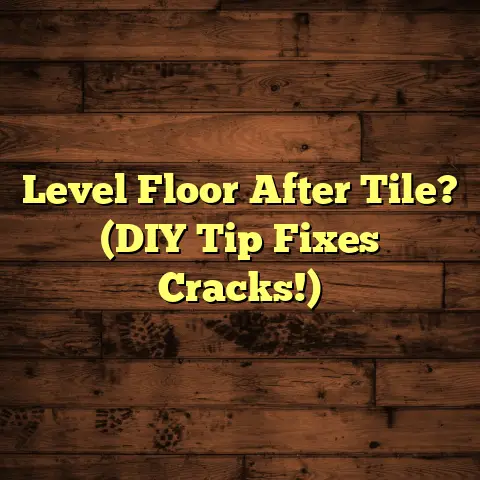Laminate Boxes: How Many Needed? (7% Waste Factor!)
Ever stood in your living room, surrounded by stacks of laminate boxes?
The promise of a new floor shimmers, but a nagging question lingers:
How many boxes do you really need?
It’s a question that can make or break your flooring project.
Run short, and you’re stuck with delays. Overbuy, and you’re throwing money away.
And then there’s the dreaded waste factor. Ignore it, and you’re asking for trouble.
Trust me, I’ve seen it all in my years as a flooring contractor.
I’ve seen homeowners beaming with pride at their DIY skills,
and I’ve seen them tearing their hair out because they miscalculated.
That’s why I’m here to guide you through the laminate maze.
We’ll tackle measurements, calculations, and that all-important waste factor.
By the end of this article, you’ll be a laminate pro, ready to conquer your project with confidence.
Section 1: Understanding Laminate Flooring
So, what is laminate flooring anyway?
It’s a synthetic flooring product made of several layers bonded together.
Typically, you’ve got a core layer made of high-density fiberboard (HDF) or medium-density fiberboard (MDF).
Then there’s the decorative layer, a photographic image that mimics wood, stone, or tile.
Finally, a clear wear layer protects the decorative layer from scratches and wear.
Laminate’s popularity stems from its durability, affordability, and ease of installation.
Plus, it looks pretty darn good!
Compared to hardwood, it’s much more scratch-resistant and easier to clean.
But, not all laminates are created equal.
You’ll find different thicknesses, designs, and durability ratings.
Thicker laminates tend to be more durable and feel more like real wood underfoot.
The design layer affects the overall look of your floor.
And the durability rating, usually an AC (Abrasion Class) rating, tells you how well it can withstand wear and tear.
These factors influence how much you need. A thinner, less durable laminate might require more frequent replacement, so you might want to buy extra for future repairs.
Section 2: The Importance of Accurate Measurements
Alright, let’s get down to brass tacks: measuring your room.
This is crucial.
A mistake here can throw off your entire calculation and leave you short on materials.
Start by sketching a rough outline of the room. Note the length and width of each wall.
For rectangular rooms, it’s simple: length x width = square footage.
But what about irregular shapes?
Divide the room into smaller rectangles or squares, calculate the area of each, and then add them together.
Don’t forget to account for obstacles like cabinets, islands, or staircases.
You’ll need to subtract their area from the total room square footage.
Pro Tip: Measure twice, cut once!
Seriously, double-check your measurements. It’s better to be safe than sorry.
I once had a client who measured in inches instead of feet.
Let’s just say they ended up with a lot of extra laminate.
Another common mistake is forgetting to account for doorways or hallways.
These areas need flooring too!
Real-Life Scenario: Imagine you’re flooring a living room that’s 15 feet long and 12 feet wide.
That’s 15 x 12 = 180 square feet.
But there’s also a fireplace that takes up 4 square feet.
So, you need 180 – 4 = 176 square feet of laminate.
See how important accurate measurements are?
Section 3: Calculating the Number of Boxes Needed
Now for the fun part: calculating how many laminate boxes you need.
First, you need to know the square footage covered by each box.
This information is usually printed on the box itself.
Let’s say each box covers 20 square feet.
Remember our living room from before? It needs 176 square feet of laminate.
Divide the total square footage needed by the square footage per box: 176 / 20 = 8.8 boxes.
But wait! You can’t buy 0.8 of a box.
You’ll need to round up to 9 boxes.
Easy, right?
Not so fast.
We haven’t factored in the waste factor yet.
Section 4: The 7% Waste Factor Explained
Ah, the waste factor.
This is where things get a little tricky, but it’s essential for avoiding disaster.
The waste factor accounts for cuts, mistakes, and damaged planks during installation.
A general rule of thumb is to add 5-10% to your total square footage to account for waste.
I usually recommend 7% for most laminate installations.
It’s a good balance between being conservative and not overbuying.
But, the waste factor can vary depending on the complexity of your room and your installation skills.
Rooms with lots of angles or curves will generate more waste.
And if you’re a beginner, you might make more mistakes than an experienced installer.
So, how do you calculate the waste factor?
Multiply your total square footage by the waste percentage.
In our living room example, we needed 176 square feet of laminate.
7% of 176 is 176 x 0.07 = 12.32 square feet.
Add that to your total square footage: 176 + 12.32 = 188.32 square feet.
Now, divide that by the square footage per box: 188.32 / 20 = 9.42 boxes.
Round up to 10 boxes.
See?
The waste factor can make a big difference.
Without it, you would have bought 9 boxes and potentially run short.
Industry Insight: According to the North American Laminate Flooring Association (NALFA), “Proper planning and a waste factor are crucial for a successful laminate flooring installation.” NALFA Website
Section 5: Real-Life Case Studies
Let me share a few stories from the trenches.
I once worked with a homeowner who was determined to save money by skipping the waste factor.
They measured their room perfectly, calculated the exact number of boxes needed, and bought only that amount.
Halfway through the installation, they ran out of laminate.
They had to special order more, which took several days.
The project was delayed, and they ended up paying more for shipping.
And the worst part?
The new batch of laminate didn’t quite match the old batch, so the floor had a noticeable color difference.
Another time, I worked with a contractor who underestimated the waste factor for a complex room with lots of angles.
They ended up with a pile of unusable scraps and had to scramble to find more laminate.
The project was completed, but it was stressful and costly.
These stories aren’t unique.
I’ve heard countless tales of woe from homeowners and contractors who underestimated the importance of the waste factor.
Don’t let it happen to you!
Section 6: Frequently Asked Questions
Q: What if I have leftover laminate?
A: Save it! You can use it for future repairs or small projects.
Q: Can I return unopened boxes of laminate?
A: It depends on the store’s return policy. Check before you buy.
Q: Is it better to overestimate or underestimate the number of boxes I need?
A: Overestimate! It’s always better to have too much than not enough.
Q: Does the type of laminate affect the waste factor?
A: Yes. Thinner, more brittle laminates may generate more waste.
Q: Can I use a higher waste factor than 7%?
A: Absolutely. If you’re a beginner or your room is complex, a higher waste factor is a good idea.
Conclusion
So, there you have it: the laminate dilemma solved.
By understanding laminate flooring, measuring accurately, calculating the number of boxes needed, and accounting for the waste factor,
you can tackle your flooring project with confidence.
Remember, the stakes are high.
You’re not just buying flooring; you’re transforming your home.
Don’t let miscalculations ruin your dream.
Plan carefully, measure twice, and always factor in the waste.
With a little knowledge and preparation, you can create a beautiful, durable floor that you’ll enjoy for years to come.
And who knows?
Maybe you’ll even become a laminate pro yourself!





